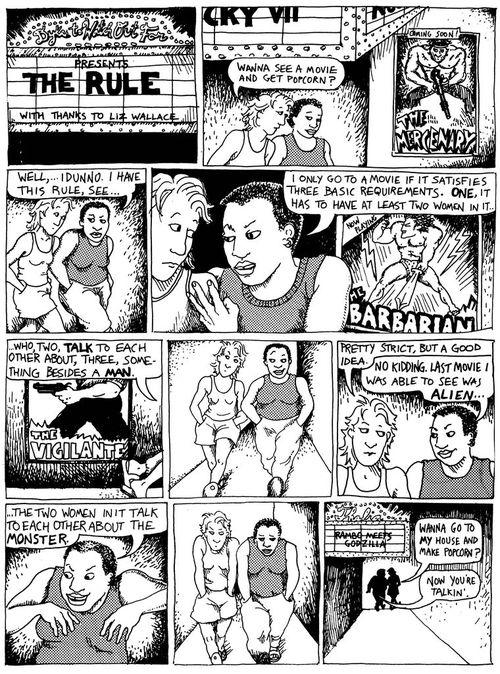About
The Bechdel Test is a collection of three questions that can be posed to a film to see how it handles its female characters (or lack thereof). It originally comes from the comic strip Dykes to Watch Out For created by American comic artist Alison Bechdel. The test can also be applied to other forms of visual media such as television and video games.
Origin
The test can originally be found in a strip published in 1985 titled “The Rule.” The strip shows two friends walking past a movie theater as one explains to the other the three things a film must have for her to see the film:
“One, it has to have a least two women in it, who, two talk to each other, about, three, something besides a man.”
She then explains the last movie she was able to see based on her rules was Alien, which had been released six years prior in 1979.
Spread
On June 30th, 2008, Jennifer Kesler published a post titled “Why film schools teach screenwriters not to pass the Bechdel test” on the film blog The Hathor Legacy.[7]
The first entry for The Bechdel Test on Urban Dictionary[1] was entered by user AutumnDevi on May 9th, 2009, which defines the term as:
“A test for movies. In order to “pass” a movie must have
1) At least two named female characters who
2) talk to each other about
3) something other than a man"
On December 7th, 2009, the YouTube channel feministfrequency[4] uploaded a video titled “The Bechdel Test for Women in Movies” that examined the standard and listen many films that don’t pass the test such as Bruno, Ghostbusters, and Clerks. As of March 2014, the video has gained over 730,000 views.
On April 11th, 2010, bechdeltest.com[3] was created, which hosts a list of movies that indicates if they pass the test, or if they pass certain points but not others.[5]
In 2013 a handful of movie theaters in Sweden began issuing “A” ratings to movies that passed the test.[2]
Several film lists of major films that past the test were compiled in 2013 and 2014 including ones on Total Film[6] and Vocativ.[8]
Criticism
On November 13th, 2013, IndieCritic[10] ran a post titled "Does It Matter If the Bechdel Test “Fails” Feminist Films?" that suggests the test can let films that do not treat women well slide, while ignoring female dominated films like Sex and the City: 2. On January 7th, 2014, Slate[9] published a post titled “The Bechdel Test Sets the Bar Too Low. Let’s Write a New One” that discussed the tests shortcomings.
Search Interest
External References
[1]Urban Dictionary – The Bechdel Test
[2]The Guardian- Swedish cinemas take aim at gender bias with Bechdel test rating
[3]Bechdel Test – The Bechdel Test
[4]YouTube – feministfrequency
[5]Internic – Blechdeltest.com
[6]Total Film – 50 Greatest Films That Pass The Bechdel Test
[7]The Hathor Legacy – Why film schools teach screenwriters not to pass the Bechdel test
[8]Vocativ – Hollywood Movies With Strong Female Roles Make More Money
[9]Slate – Hollywood Movies With Strong Female Roles Make More Money
[10]Indie Wire – Does It Matter If the Bechdel Test “Fails” Feminist Films?
